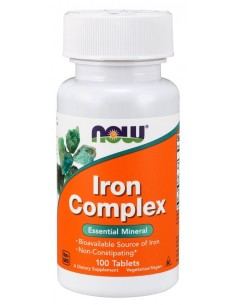Iron
To understand what an iron supplement is, it's important to know the basic function of iron and why it's so vital to overall health. Iron is normally obtained by eating certain foods, such as red meat, liver (and other offal), spinach, and more.
It is found in almost every human cell and is considered an essential mineral because it is needed to produce the part of red blood cells called hemoglobin. Hemoglobin is responsible for transporting vital oxygen throughout the body and to the brain, which has a very high oxygen requirement.
Iron is involved in oxygen transport, energy production, immune activity, hormone production, energy for muscles and DNA.
Iron deficiency anemia
Iron deficiency is the most common nutritional deficiency in the world according to the World Health Organization (WHO). About 20 percent of the world's population is reportedly iron deficient.
According to the WHO, "Every age group is vulnerable. Iron deficiency impairs the cognitive development of children from infancy to adolescence. It damages immune mechanisms and is associated with increased rates of morbidity [disease].
"During pregnancy, iron deficiency is associated with multiple adverse outcomes for both mother and baby, including an increased risk of bleeding, sepsis, maternal mortality, perinatal mortality and low birth weight.
"It is estimated that almost all women are iron deficient to some degree and that more than half of pregnant women in developing countries suffer from anemia."
The most common symptom of anemia caused by iron deficiency is extreme fatigue. Other symptoms may include shortness of breath, brittle nails or vertical ridges on the nails, dry and damaged hair, headaches and dizziness.
In addition, a person with iron deficiency may experience weakness, pale skin, inflammation or soreness of the tongue and mouth, cold hands and feet, and/or chest pain or a rapid pulse.
Health Benefits of Iron
The main benefit of iron is its ability to prevent low levels of iron in the blood, preventing sideropenic anemia in those who are at high risk.
People who commonly have low iron levels include breastfed or formula-fed infants who are not sufficiently fortified with iron, and children who may not be eating an adequate diet with enough iron and need adequate iron due to rapid growth.
Others who may experience low iron levels include vegetarians because vegetables have less iron than meat, the elderly who often have nutritional deficiencies due to health problems, depression, poverty or inadequate access to healthy food, and athletes because of the need for more oxygen to work their muscles.
Women also need higher levels of iron than men, as do pregnant people (due to increased demand for iron during pregnancy). Those taking certain medications may also manifest low iron levels (such as those taking oral contraceptives, aspirin, steroids, antacids, and blood thinners).
Chelated iron
Chelated iron is known by many generic and brand names. Ferrous bisglycinate chelate is one of the most common generic names, commonly known as iron bisglycinate. Iron chelate is also known as, among many other names:
- Ferrous bisglycinate quelate (IS)
- Iron Bisglycine II (IS)
- Iron bisglycino (II) chelate (IS)
- Eisen(II)-bisglycinate (IS)
- Ferrous glycinate (IS)
- Iron glycinate (IS)
Chelated iron is also said to reduce the incidence of stomach upset commonly associated with taking iron supplements. But some experts disagree that clinical research supports these claims, stating that regular iron (ferrous sulfate) works just as efficiently.
It's important to note that chelated iron may not be potent enough to treat severe iron deficiency (particularly with anemia), but it is useful for maintaining iron levels and preventing the occurrence of iron deficiencies in those who are at high risk.
Research on chelated and unchelated iron
A study of pregnant women with iron deficiency, published in the Journal of Perinatal Medicine, found that there was no difference between study participants who were given chelated (bisglycinate) iron and those who were given normal (ferrous sulfate) iron.
This would indicate that the claims that chelated iron is better absorbed may not be true, and therefore the more expensive price of chelated iron supplements (compared to regular iron) may not be justified.
Another 2014 study showed that 30 milligrams of chelated iron taken for 90 days was just as effective as ferrous sulfate in maintaining normal iron levels in school-aged children who had low iron levels (without anemia).
However, in a separate study that compared chelated iron with ferrous sulfate, those who took the amino acid chelate supplement reported significantly fewer side effects (including less stomach discomfort) than those who took the non-chelated ferrous sulfate.
In a previous animal study, chelated iron was found to cause fewer adverse effects than the use of other iron preparations. Ferrous sulfate (unchelated iron) caused more intense toxicity symptoms than equal doses of chelated iron.
A 2013 study of preschoolers found that both the ferrous sulfate group (normal iron) and the amino acid chelate group (chelated iron) showed equal adverse reactions, but chelated iron resulted in a greater increase in ferritin concentration.
Ferritin concentration is an indication of iron concentration in the blood. However, the study also showed that hemoglobin levels did not change after administration of the iron supplements.


